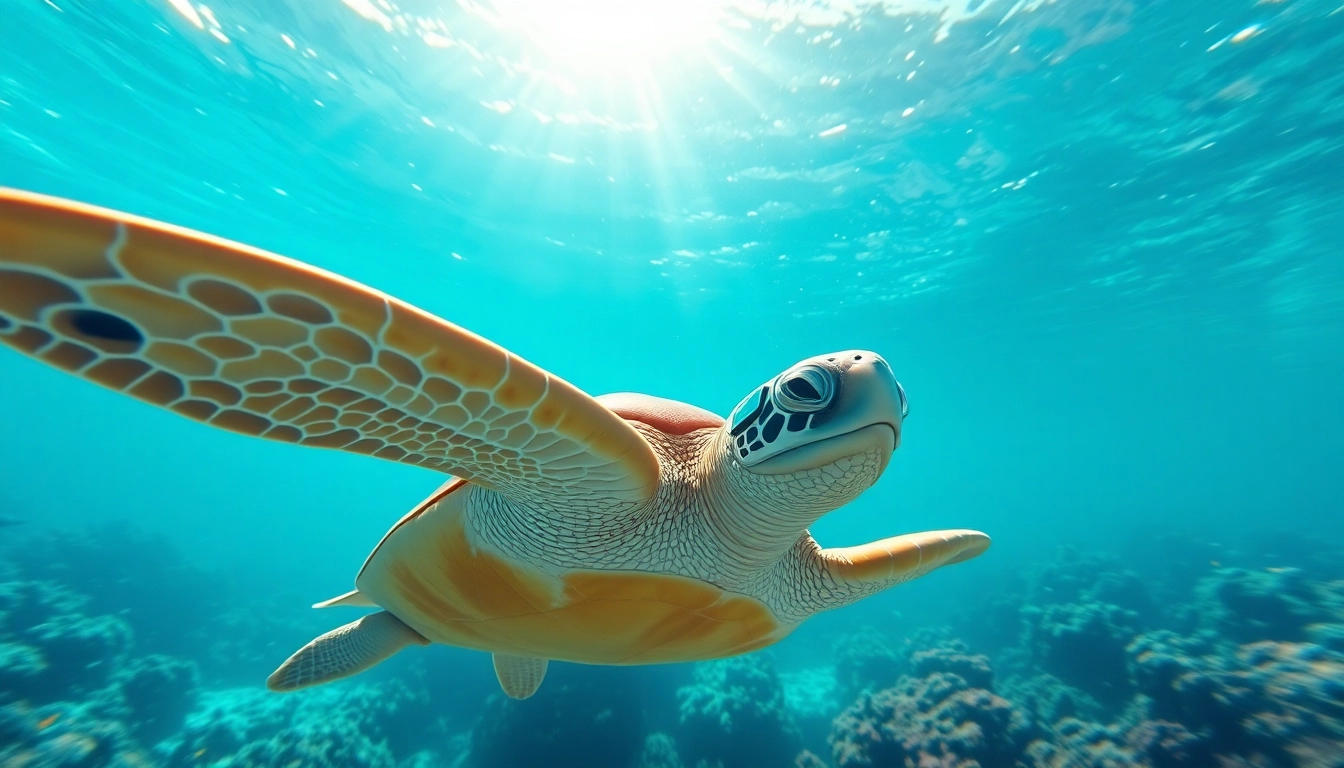Understanding the Turtle Snorkel
What is a Turtle Snorkel?
The turtle snorkel is a versatile and user-friendly snorkeling apparatus specifically designed to enhance the underwater experience for both beginners and seasoned snorkelers. With its unique design that often features a comfortable mouthpiece and a one-way purge valve, the turtle snorkel operates by allowing divers to breathe with minimal effort while keeping water out. The main goal is to let snorkelers enjoy the aquatic world without the fuss of traditional snorkeling setups.
Benefits of Using Turtle Snorkel
Choosing a turtle snorkel comes with a myriad of benefits, making it a preferred choice among snorkeling enthusiasts. Here are some key advantages:
- Easy Breathing: The innovative design allows for effortless breathing, particularly suitable for those new to the activity. The valve systems enable users to exhale without the fear of water entering the snorkel.
- Enhanced Comfort: The mouthpiece is typically ergonomic, reducing jaw fatigue during prolonged use. This is particularly advantageous during longer snorkeling sessions.
- Clear Visibility: Many turtle snorkels come equipped with features that minimize fogging, which enhances the clarity of vision while exploring underwater.
- Portability: The lightweight and compact nature of turtle snorkels makes them easy to carry, ensuring that they can accompany snorkelers on any adventure.
- Affordability: Generally, turtle snorkels are priced competitively, making them an accessible choice for various budgets.
Common Features of Turtle Snorkel
Turtle snorkels are characterized by several common features that contribute to their performance and user-friendliness. Understanding these features can assist you in making the right choice:
- Dry Top Design: Many models come with a dry-top feature, preventing water from entering when submerged. This is essential for maintaining a dry breathing experience.
- Purge Valve: The one-way purge valve at the bottom allows snorkelers to expel any residual water without having to remove the snorkel.
- Flexible Tube: The tube’s flexibility offers snorkelers the ability to maneuver easily while keeping the apparatus in place, adding to the comfort.
- Adjustable Straps: Most turtle snorkels include adjustable straps for a customizable fit, ensuring security during intensive movement in the water.
Choosing the Right Turtle Snorkel
Factors to Consider
When selecting a turtle snorkel, it’s crucial to consider various factors that influence comfort, safety, and overall experience. Key factors include:
- Water Conditions: Different snorkeling environments can affect your choice of snorkel. If you plan to snorkel in turbulent waters, a model with a dry top might be best.
- Your Experience Level: Beginners might prefer a straightforward design that offers ease of use, while experienced snorkelers might look for advanced features.
- Comfort Level: The fit of the mouthpiece and the weight of the snorkel should feel comfortable during use to prevent fatigue.
- Compatibility with Masks: Ensure that your chosen snorkel is suitable to pair with your mask for optimal performance.
Size and Fit for Comfort
The size and fit of the turtle snorkel are paramount for a comfortable snorkeling experience. Here are some tips for ensuring a proper fit:
- Measure your face and select a mouthpiece that suits your jaw size.
- Look for adjustable straps and a flexible tube that allows for movement without discomfort.
- Try on the snorkel with your mask before purchasing to check for any leaks or discomfort.
Materials and Durability
The materials used in the manufacturing of turtle snorkels significantly impact their durability and functionality. Common materials include:
- Silicone: Known for its flexibility and comfort, silicone mouthpieces are often highly recommended.
- Polycarbonate: Widely used for snorkel tubes due to its strength and resistance to impact.
- Nylon or Neoprene for Straps: These materials offer durability and comfort for the snorkel straps, ensuring a snug fit without irritation.
Proper Use of Turtle Snorkel
Getting Started with Turtle Snorkel
Once you’ve selected your turtle snorkel, it’s essential to familiarize yourself with proper usage. Here’s how to get started:
- Always pre-rinse your snorkel before the first use to remove any manufacturing residues.
- Practice breathing through the snorkel while in shallow water before venturing into deeper areas.
- Have a buddy system in place, especially while you’re still learning the ways of the water.
Safety Measures While Snorkeling
Safety is paramount when snorkeling, especially when using a turtle snorkel. Here are several essential safety measures to follow:
- Always snorkel with a partner to increase safety in case of emergencies.
- Stay aware of your surroundings and avoid strong currents or busy boat areas where waves can be dangerous.
- Use a flotation device if needed and avoid snorkeling alone, particularly if you are a beginner.
- Know your limits and take breaks to avoid exhaustion.
Techniques to Enhance Visibility
Visibility is a crucial factor in enjoying the vibrant underwater ecosystem. Implement the following techniques for better visibility:
- Equalize Pressure: To avoid pain and maintain clearer vision, equalize pressure in your ears as you descend.
- Avoid Stirring Up Sediment: When swimming, try to minimize splashing or movements that can create sediment clouds.
- Use Anti-Fog Solutions: Applying anti-fog liquids or using spit can prevent fogging on your snorkel’s viewing area.
Maintenance and Care for Turtle Snorkel
Cleaning Your Turtle Snorkel
Regular maintenance and cleaning of your turtle snorkel are essential to prolonging its life and ensuring safe use. Here’s a guide on how to clean your snorkel:
- After every use, rinse the snorkel thoroughly with fresh water to remove salt, sand, and other debris.
- Use a mild soap solution and a soft brush to clean the interior and exterior. Avoid harsh chemicals that may damage the material.
- Make sure the purge valve is clear and functioning properly.
Storage Tips for Longevity
The way you store your turtle snorkel can significantly affect its durability. Keep these storage tips in mind:
- Store in a cool, dry place away from direct sunlight to prevent material degradation.
- Keep the snorkel in a protective bag or case to avoid potential damage.
- Avoid leaving it in a damp environment where mold could develop.
When to Replace Your Equipment
Knowing when to replace your turtle snorkel is crucial for maintaining your snorkeling experience. Here are signs that it might be time for a new snorkel:
- If the mouthpiece becomes cracked or degraded, it’s time for a replacement.
- Check for leaks—if water consistently enters the snorkel despite using it correctly, consider a new model.
- Fading or deterioration of the tube can indicate wear; replace it to ensure safety while snorkeling.
Best Locations for Snorkeling with a Turtle Snorkel
Top Destinations Worldwide
For those using a turtle snorkel, some of the world’s premier snorkeling destinations include:
- The Great Barrier Reef, Australia: Home to an unparalleled variety of sea life, this reef is a must-visit for snorkelers.
- Hanauma Bay, Hawaii: A beautiful marine embayment with calm waters, ideal for beginners.
- Belize Barrier Reef: A UNESCO World Heritage Site teeming with vibrant ecosystems, perfect for adventure seekers.
Local Spots to Explore
In addition to global destinations, there are countless local spots that provide excellent snorkeling opportunities. Research your local beaches or lakes for calmer waters and natural beauty.
Conservation Considerations When Snorkeling
As a responsible snorkeler, it’s essential to adhere to conservation practices to protect aquatic ecosystems. Here’s how you can contribute:
- Avoid touching marine life and coral to prevent damage to delicate ecosystems.
- Use reef-safe sunscreen to minimize chemical impact on marine life.
- Educate yourself on local conservation guidelines and adhere to them during your snorkeling adventures.



